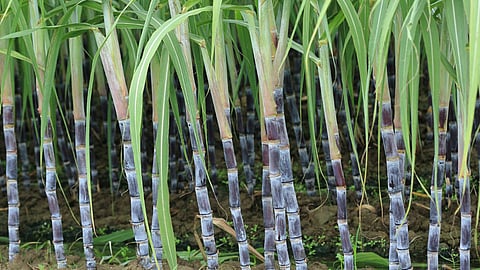‘Miracle play’and the red dot disease
In 2016-17, UP had become the largest sugar producer in the country, toppling Maharashtra. The high yielding Co 0238 sugarcane variety has been touted as one of the reasons for UP moving to the top slot. Co 0238 variant is also called the miracle variety/high yielding variety. According to the information available on the Indian Council of Agricultural Research’s (ICAR) website, sugarcane variety Co 0238, was recommended for UP in 2012-13. ICAR says that this variety has a rare combination of cane yield and sugar recovery. Due to this, sub-tropical India embraced this variety and was pronounced in UP.
According to ICAR, at the national level for 2019-20 sugar season (October-September), Co 0238 accounted for 53.20 per cent, the highest percentage covered by a single variety. “The average cane productivity has increased from 61.6 t/ha during 2012-13 to 80.5 t/ha during 2018-19,” informs ICAR. “Similarly, the sugar recovery has improved from 9.18 per cent to 11.46 per cent during the corresponding years.” Clearly, productivity has increased by nearly 31 per cent and sugar recovery by 2.28 per cent.
UP has been on the top since 2016-17. Alarm bells started ringing in 2020-21, when red rot disease started affecting this miracle variety. “With the increasing incidence of red rot reported in Co 0238 throughout Eastern UP and some parts of Central UP, we have initiated varietal replacement plan at all our sugar units,” informs Triveni Engineering & Industries in its Annual Report for 2020-21. “Besides focussing on propagation of tested varieties, such as Co 118, Co 98014, CoLk 94184, Co J85 (along with CoJ 88, an improved variety), new varieties – Co 15023 & Co S13235 – are being explored. Techniques such as single bud planting are also being adopted for faster propagation of the varieties.”
A similar observation was made by DCM Shriram, which said in its Annual Report for 2020-21: “Recently, Co 0238 sugarcane variety in Uttar Pradesh has seen increased incidences of red rot, thereby impacting sugar production by almost 10 per cent in the state. Its future impact needs to be assessed, although the industry has already started taking measures to promote new varieties.”
Maharashtra on top again
For various reasons, including red rot affecting Co 0238, Maharashtra had toppled UP in 2021-22, as the top sugar producer and it is expected to retain its position in 2022-23, as per estimates of industry bodies.
A second advance estimate made by the Indian Sugar Mills Association (ISMA) informs that sugar production for 2022-23 (Sugar Season: October 2022-September 2023) is estimated at 34 million tonnes, as against 35.8 million in 2021-22 – a drop of 1.8 million tonnes. (Sugar production numbers are taken after excluding sugar for ethanol.)
The largest sugar producing states in India are Uttar Pradesh: 10.1 million tonnes (10.20 million tonnes), Maharashtra: 12.1 million tonnes (13.7 million tonnes) and Karnataka: 5.6 million tonnes (6 million tonnes). The All India Sugar Traders Association (AISTA) has estimated sugar production for 2022-23 at 33.50 million, which covers Uttar Pradesh: 10.8 million tonnes (10.20 million tonnes), Maharashtra: 11.30 million tonnes (13.70 million tonnes) and Karnataka: 5.50 million (6.20 million tonnes).
While ISMA estimates a slight drop in sugar production in Uttar Pradesh, AISTA has projected sugar production in UP to increase by 0.60 million tonnes. Fall in production in Maharashtra has been attributed to rains.
Is Co 0238 a waning variety? When asked at a conference with analysts, held after announcing its third quarter results in February this year, Avantika Saraogi, business lead, Balrampur Chini Mills, said: “About varietal balance, definitely, it’s safe to say Co 0238 is a waning variety. And, as we stand today, we are already in a good varietal balance in ratoon as well as plant. We have 4-5 good varieties in the pipeline and any dependence on any single variety is completely reduced.
So, anytime we see anything happening, we are free to switch within a year itself. Having said that, if it is going to be 4-5 varieties, we would not ideally like to take any one variety more than 30 per cent – say, between 20 per cent and 30 per cent – depending on the conditions of any particular factory. That’s all I can say; and even now this is underplay.”
In an analyst conference held in February this year by Dwarikesh Sugar Industries, one of the analysts without naming the variety asked: “Do you expect the dominant variety to be replaced by next year?” Vijay S. Banka, managing director, answered: “It is going to be a three-year programme, but the efforts will, I mean, results will be visible from the next year onwards.”
The question is: Is it a case of putting all eggs in one basket?

